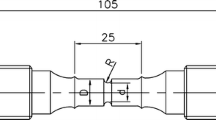Conclusions
-
1.
The notch sensitivity of structural steels increases (practically linearly) when the proportion of high-strength structural components (sorbite and pearlite) in their structure increases; this is determined by their suitability for more intense piling up of dislocations at obstacles.
-
2.
The greater notch sensitivity of the high-strength structural components is the reason why the fatigue limit of specimens with stress raiser increases less with increasing tensile strength than the fatigue limit of smooth specimens, and from some value of σu onward it remains practically unchanged (and in isolated cases even decreases). The use of high-strength steel, especially temper hardened one, is therefore not always expedient.
-
3.
The rate of increase of the fatigue limit of specimens due to increased σu slows down when the stress concentration increases and also under the effect of the scale factor.
-
4.
For making parts subjected to fatigue in operation, it is best to use steels with high static strength and to apply surface plastic strain (SPS) to them. The effectiveness of strengthening by SPS increases with increasing σu of the steels.
Similar content being viewed by others
Literature cited
D. N. Reshetov, Machine Parts [in Russian], Mashinostroenie, Moscow (1974).
I. V. Kudryavtsev, V. M. Andrenko, and E. A. Rymynova, “The effect of the scale factor on the fatigue of notched shafts”, Vestn. Mashinostr., No. 1, 24–26 (1975).
V. A. Masol, I. V. Kudryavtsev, M. Ya. Belkin, and V. N. Tarasova, “Endurance of large shafts with press fit”, Vestn. Mashinostr., No. 9, 10–13 (1971).
M. Ya. Belkin, V. A. Masol, N. M. Savvina, and V. I. Rulev, “Endurance of shafts of carbon and alloy steels”, Probl. Prochn., No. 3, 109–113 (1977).
M. N. Stephov, Statistical Processing of Results of Mechanical Tests [in Russian], Mashinostroenie, Moscow (1972).
M. Ya. Belkin, “Finding the optimal structures and technology of surface hardening of large steel shafts for the purpose of improving their fatigue strength”, Author's Abstract of Doctoral Thesis, Donetsk (1980).
N. A. Shokov and N. M. Savvina, “The causes of increased effectiveness of hardening by surface plastic deformation when the cross section of parts is larger”, Metalloved. Term. Obrab. Met., No. 3, 14–17 (1984).
S. A. Saltykov, Stereometric Metallography [in Russian], 3rd revised and enlarged edition, Metallurgiya, Moscow (1970).
N. F. Mott, Philos. Mag.,43, (1952).
V. A. Krokha, Strengthening of Metals by Cold Plastic Strain (Handbook) [in Russian], Mashinostroenie, Moscow (1980).
I. A. Oding, Theory of Dislocations in Metals and Its Application [in Russian], Izd. Akad. Nauk SSSR, Moscow (1959).
M. A. Shtremel' and B. G. Belyakov, “Possibilities of measuring dislocation density by electron microscope”, Fiz. Met. Metalloved.,25, No. 1, 140–151 (1968).
M. Ya. Belkin, T. I. Shelyagina, and L. M. Belkin, Change of Substructure in Fatigue in Connection with the Initial Structure of Steel [in Russian], Deposited at VINITI March 3, 1982, No. 896-82, Kuibyshev (1982).
Additional information
Kramatorsk Industrial Institute. Translated from Metallovedenie i Termicheskaya Obrabotka Metallov, No. 1, pp. 34–39, January, 1989.
Rights and permissions
About this article
Cite this article
Belkin, A.M., Belkin, M.Y., Vishnevskii, A.P. et al. Notch sensitivity of structural steels in different structural states. Met Sci Heat Treat 31, 42–49 (1989). https://doi.org/10.1007/BF00735328
Issue Date:
DOI: https://doi.org/10.1007/BF00735328




